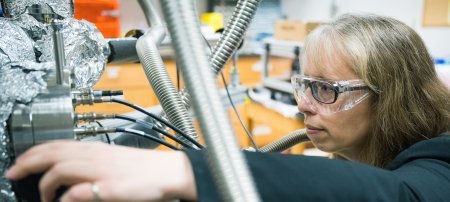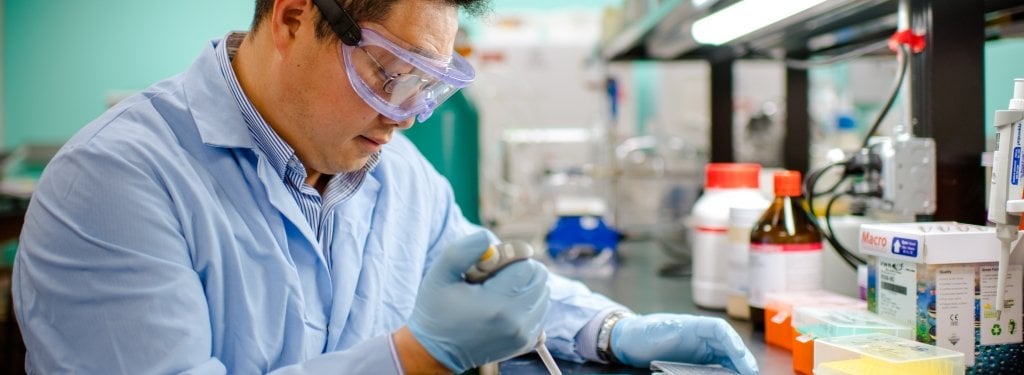Sometimes the limitations of materials create roadblocks in energy research. But that does not daunt Yun Hang Hu, the Charles and Carroll McArthur Professor within the Department of Materials Science and Engineering.
Hu’s groundbreaking work has led to several brand-new materials and processes. The innovations will help in a number of applied technologies—from supercapacitors that run elevators to solar cell banks to computer data storage to making hydrogen fuel from water and sunlight. The breadth and rigor of Hu’s work has been recognized with Michigan Tech’s highest research award honor this past year—the 2017 Research Award. He was also selected for the 2017 Bhakta Rath Award with his recently graduated PhD student, Wei Wei. Hu is the first faculty member to receive both awards simultaneously.

The key to Hu’s success is that he is willing to push the boundaries; he takes what could be and turns ideas, conceptions, and models into reality. Stephen Kampe, chair of the Department of Materials Science and Engineering, calls Hu “an international leader in energy research for his innovative processing of materials. He is one of the few researchers to excel in both theory and experimental work.”
Considering a new material and then creating it in a lab is no small feat. And Hu has synthesized several new materials along with novel reactions for others. One example is a new class of memrister materials, which are electrical circuits made of molybdenum disulfide nanosheets that can potentially store massive amounts of data in a miniscule amount of space on a computer. Memristers could make today’s iPhones as powerful as a supercomputer.
The bulk of Hu’s research, however, focuses on energy-related materials. He created solid solution catalysts for natural gas conversion, highly efficient materials for energy devices and hydrogen storage, and novel processes for hydrogen production and capturing carbon dioxide. In one finding, Hu and his lab detailed how carbon dioxide can also be used to synthesize 3-D graphene and create tiny surface dents in it—a balance of micropores and mesopores increases the surface area available for adsorption of electrolyte ions.

“The new 3-D surface-microporous graphene solves the difficulty of limited charging time in activated carbon,” Hu says, explaining it comes down to how quickly an electrolyte can diffuse and recharge in a supercapacitor electrode material. “The interconnected mesopores are channels that can act as an electrolyte reservoir and the surface-micropores adsorb electrolyte ions without needing to pull the ions deep inside the micropore.”
It is also well-known that a large accessible surface area and high electrical conductivity are both required for ideal functioning of electrode materials in energy devices. But the materials traditionally used in these electrodes—activated carbon and graphite—offer one but not the other. The activated carbon has a large surface area but low conductivity; graphite has high conductivity but a low surface area. The solution, Hu says, is sodium.
“Doping alkali metals into carbon materials was demonstrated several decades ago to create highly conductive carbon materials,” Hu explains. “However, as the metals are located on the carbon surface, they can be easily oxidized, leading to a decrease in conductivity. I thought that, to solve this issue, alkali metal atoms must be completely surrounded by carbon atoms to form an alkali-metalembedded carbon material.”

To synthesize alkali-metal embedded carbon, Hu figured that the alkali metal atoms must be present in the reaction system before carbon formation. Along with his recently graduated PhD student, Wei, who is now an assistant professor at Wichita State University, Hu was able to establish a reaction between sodium metal and carbon dioxide that could generate sodium-embedded carbon nanowalls. The work to maximize surface area and electrical conductivity—along with close to twenty other papers they co-authored during Wei’s study—earned the duo the Bhakta Rath Research Award. The award is given each year to a Michigan Tech doctoral student-advisor pair for cutting-edge research and focuses on the social contribution of the work.
“Hu and Wei used novel approaches based on their invented reactions to synthesize unique electrode materials,” says Joshua Pearce, the materials science and engineering professor who nominated them for the award. “Not only did they successfully create new processes and materials, but they kept their larger objective in mind: to assess the workability in real energy devices.”
In Hu’s lab, the boundary is thin between what is and what could be. By working at the interface of theory and experiments, Hu is building a bright future for energy devices and technology.
Michigan Technological University is an R1 public research university founded in 1885 in Houghton, and is home to nearly 7,500 students from more than 60 countries around the world. Consistently ranked among the best universities in the country for return on investment, Michigan's flagship technological university offers more than 120 undergraduate and graduate degree programs in science and technology, engineering, computing, forestry, business, health professions, humanities, mathematics, social sciences, and the arts. The rural campus is situated just miles from Lake Superior in Michigan's Upper Peninsula, offering year-round opportunities for outdoor adventure.




